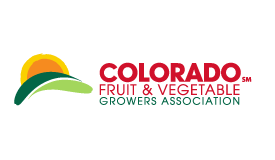CFVGA Lunch and Learn Webinar | Precooling and managing produce temperatures for quality and safety (52 minutes) December 15, 2016
- Goal of precooling is to remove field heat, cool to slow crop respiration and degradation, hamper spoilage organisms, and extend shelf life
- Too much cooling can cause chilling injury. Many warm season crops want to be stored above 40F (normal refrigerator high temperature)
- Fundamentals
- Harvest early
- Remove from Field
- Utilize shade from sun
- Packaging – vented, light colored, sized to allow for cooling
- Considerations for room cooling (walk-in cooler)
- Not the same as forced air cooling so transfer of heat from produce to room is much slower, can take 24 or more hours to cool in this method
- Airflow increases cooling rate but increases drying of produce
- Position boxes with space between and below them (>1”) for air flow (walls, boxes and floor)
- 25 – 40% of floor space must remain open for air flow
- Top icing
- Some distributors moving away from this due to cleanliness and food safety concerns
- 3 lbs of ice can cool 1 lb of produce from 86F to below 41F
- Refrigerated trailers are meant to keep produce cool, not to cool it. Space for air flow is crucial.
- Consider trailers in your food safety plan. Maintain cooler performance on the trailer.
CFVGA Lunch and Learn Webinar | High Tunnels and Season Extension in the Western USA: A Research Summary
(52 minutes) January 20, 2017
1. High tunnel/hoophouse – passively heated, walk-in, temporary growing structure
2. Data from this fall/winter high tunnel (HT at 16’ wide x 32’ long) production research is most applicable to plains/lower elevations of Colorado (under 6,000 ft)
3. Double layer plastic with 50 gallon metal water barrels for thermal storage in fall and winter didn’t gain enough temp increase to warrant space lost in the HT
4. Floating row cover inside the HT made a significant temperature retention strategy (Agribon AG-19 was used) against nightly low temps . No hoops were used above the crops inside
5. HT were not ventilated in this research due to labor supply and this made for high daily temps
6. Night time differences in low temps did not create yield differences
7. Planting date was more significant influence for spinach yield. Earlier (Oct) more yield than later (Nov).
CFVGA Lunch and Learn Webinar | Reduced and No Till Vegetable Production Approaches in the West: Pros and Cons
(46 minutes) January 25, 2017
- Veg systems in semi-arid west with irrigation makes us unique in approach to reduced and no-till. Rain fed systems more prevalent further east of Colorado are different in their performance.
- gmu.edu/cropscape/
- Wheat rolled/crimped to terminate in boot stage, strip tilled with two passes, transplanted swiss chard and flood irrigated in row
- Barley terminated easily with roller/crimper
- Strip till was half the yield of the open field (conventionally tilled) yield of same swiss chard transplants
- No till sweet corn had similar yields to conventional tilled sweet corn
CFVGA Lunch and Learn Webinar | Vegetable Seed Varieties for Colorado (50 minutes) February 7, 2017
- Attributes to consider when selecting varieties: market, pest resistance, cost (hybrid vs. open pollinated), methods of establishment (see d vs transplant)
- Watch webinar for list of varieties suggested
- Colorado grows “Long Day” onions from seed or transplants
- For tomatoes, consider hybrid vs. heirloom and determinate vs. indeterminate. Many grow determinate in Colorado outdoors for reliable fruit set.
- Tomato issues: cracking (partially dependent on varieties with thick skin more prone), catfacing, viruses (tomato spotted wilt virus and curly top virus). Some varieties resistant to TSWV
- Muskmelon/cantaloupe types. Two types: Western shipper (smooth netted melon) and Eastern type (more pronounced ribs). LSL = long shelf life varieties can be important for growers to consider
- Seeded and seedless types. Different shapes and line types. Some seedless require a pollinator varieties grown nearby
- Pumpkins and squash. Some have powdery mildew resistance
- Cucurbit insects such as squash bugs, cucumber beetles have poor resistance currently
- Peppers are extremely varied in types. Problems include sun scald and foliage cover of fruit is important in variety selection and plant spacing. Shade netting can also improve yield and quality of specialty peppers. Thicker walled chiles will grow straighter and curve less when grown from transplants. Consider disease resistance with varieties: phytophthora blight, bacterial leaf spot (races 1, 2 and 3; can be seed born bacterial leaf spot if you are saving seed, sanitize it)
- Sweet corn by sweet, super sweet, etc. and white, yellow or bicolor. Earworm control: sprayed Bt, genetically engineered Bt
CFVGA Lunch and Learn Webinar | Potato Varieties for Colorado (57 minutes) February 28, 2017
- Potato breeding program objectives: increased yield, quality, resistance to pests, tolerance to environmental stresses, nutritional and flavor attributes
- Pest resistance objectives: PVY, PMTV/powdery scab, postharvest diseases, pink rot, late blight, nematodes, TRV/corky ringspot
- Markets considerations: distinctive, niche markets, new markets, consumer recognition
- Takes 14+ years to breed a new variety
- Russets are the dominant type grown in the US. CSU cultivars include: Canela, Mesa, Crestone, Mercury, Fortress (PVY and late blight resistant),
- Reds from CSU include: Colorado Rose, Rio Colorado,
- Chippers include: Chipeta
- Specialties include: Mountain Rose (red), Purple Majesty (purple), Masquerade, Harvest Moon, Red Luna, red and purple fingerlings
- Potatoes have highest potassium on a per serving basis compared to bananas, broccoli and tomatoes
- Specialties have shown to gross the highest per acre
|
